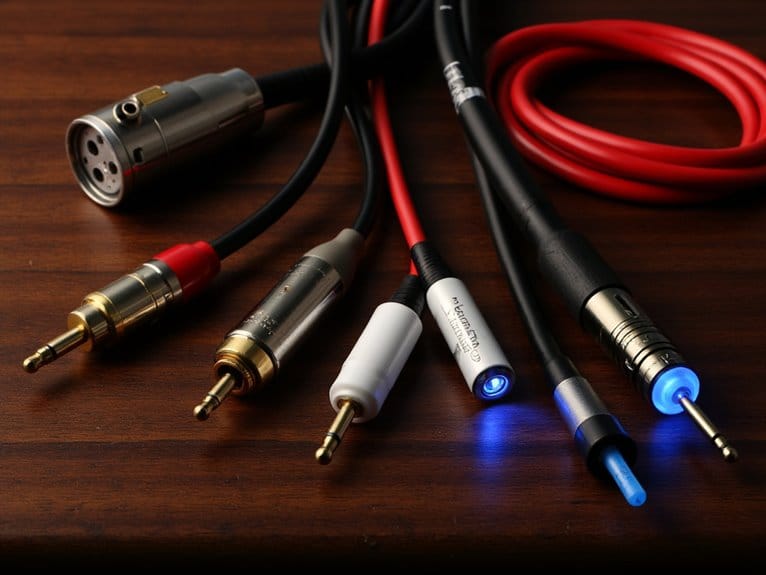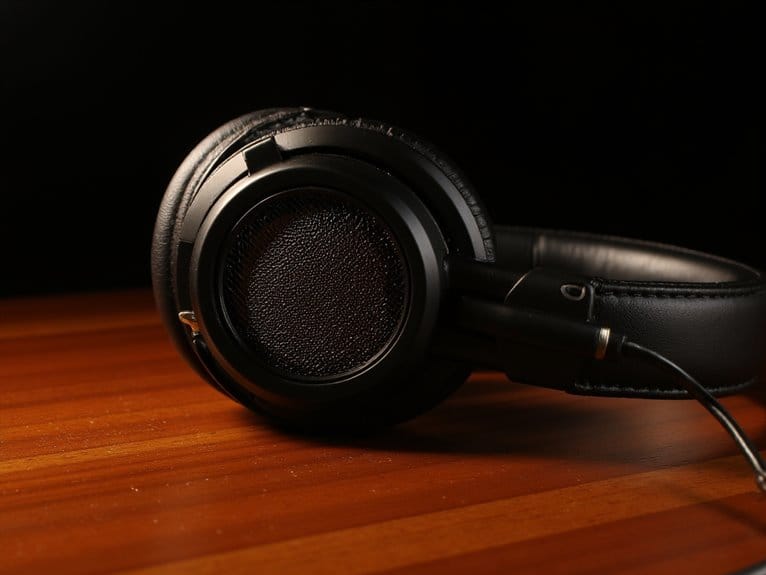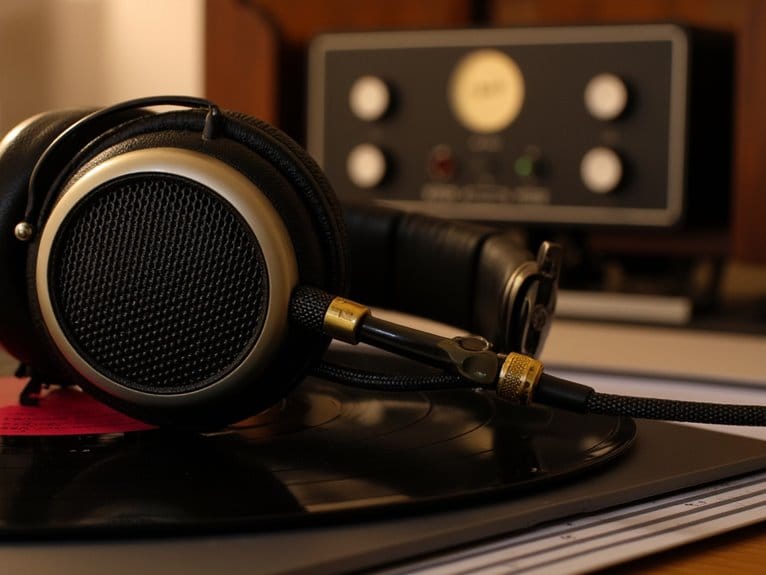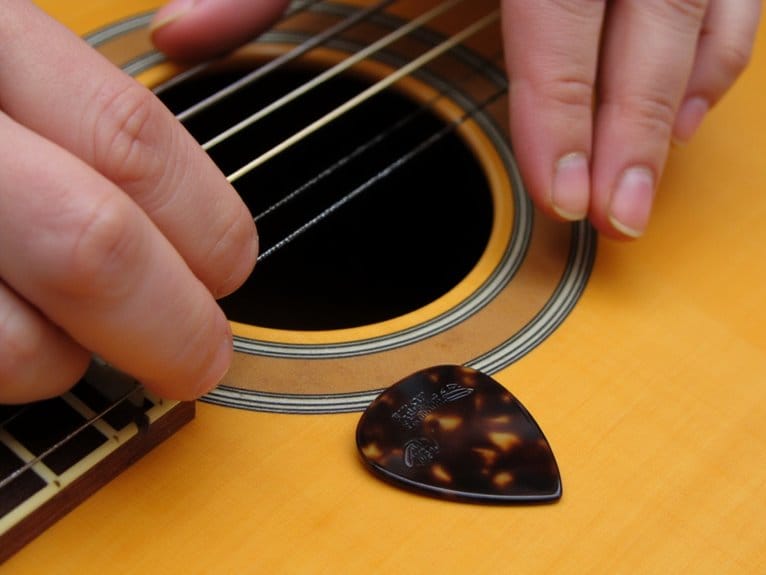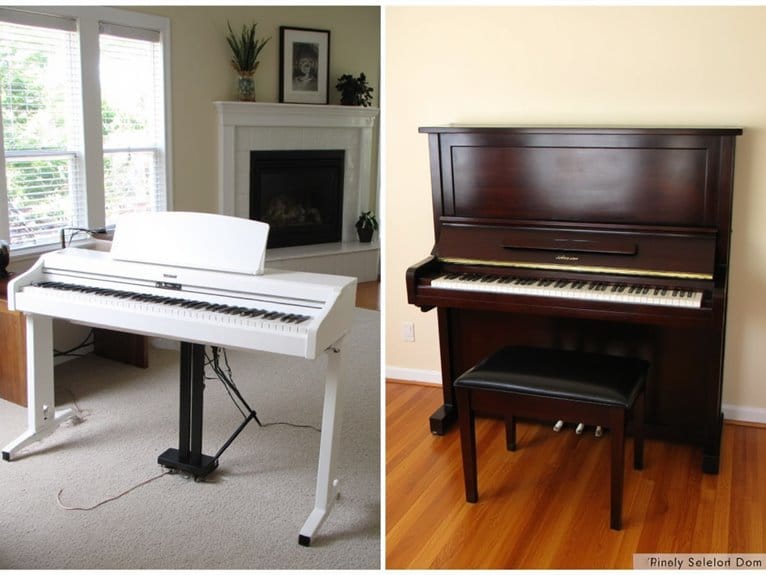How to Choose the Right Audio Cable for Your Setup
Choose cables based on your signal type and distance requirements, where balanced XLR or TRS cables work best for professional setups and runs over 20 feet due to superior noise rejection capabilities. For home guitar-to-amp connections under 15 feet, unbalanced TS cables suffice perfectly. Match your equipment’s signal levels—professional gear operates at +4 dBu while consumer equipment uses -10 dBV standards—and invest in oxygen-free copper conductors with proper shielding for ideal performance. Understanding these fundamentals will guide you toward the perfect cable selection for your specific audio applications.
We are supported by our audience. When you purchase through links on our site, we may earn an affiliate commission, at no extra cost for you. Learn more.
Notable Insights
- Identify your signal type: use TS cables for guitar connections, TRS for balanced mono/stereo, and XLR for professional applications.
- Choose balanced cables for runs over 20 feet or noisy environments; unbalanced cables work fine for short home connections.
- Match signal levels between equipment: professional gear uses +4 dBu while consumer equipment operates at -10 dBV standards.
- Select proper speaker wire gauge: 16 AWG for runs under 48 feet, 12 AWG for longer distances to prevent signal loss.
- Invest in quality construction with oxygen-free copper conductors and multi-layer shielding to reduce interference and improve sound clarity.
Understanding Audio Cable Types and Their Functions
The foundation of any quality audio setup lies in understanding the distinct roles that different cable types play in transmitting your sound signals. I’ve found that most people underestimate how dramatically the wrong cable choice can impact their audio experience.
TS cables work perfectly for connecting your guitar to an amp, carrying unbalanced mono signals with simple durability, though they’re more susceptible to noise interference.
TS cables excel at guitar-to-amp connections with reliable mono signal transmission, but expect increased noise vulnerability compared to balanced alternatives.
TRS cables offer versatility, handling both balanced mono and unbalanced stereo signals, making them ideal for studio monitors and headphones where noise reduction matters.
XLR cables provide professional-grade performance with locking connectors and excellent noise rejection over long distances. These cables utilize three pins to create stable connections that maintain signal integrity in demanding professional environments.
While cheap cables from questionable cable brands might seem tempting, investing in quality connectors guarantees reliable signal transmission and prevents frustrating audio degradation. Guitar cables with oxygen-free copper conductors deliver superior signal clarity and reduce unwanted noise in your audio chain. For studio applications, TT cables provide thinner alternatives to 1/4 inch cables and enable quick routing through patchbays for efficient workflow management.
When setting up DJ controllers, proper cabling becomes even more critical since most beginner-friendly models include built-in audio interfaces that eliminate the need for additional hardware while maintaining professional sound quality. Just as ride cymbals require careful consideration of alloy construction to achieve optimal tonal complexity, audio cables benefit from premium materials that enhance signal transmission and reduce interference.
Balanced Vs Unbalanced Signal Transmission
When you’re selecting audio cables, you’ll encounter two fundamental signal transmission methods that differ dramatically in their approach to noise rejection, acceptable cable lengths, and intended applications.
Balanced cables use sophisticated dual-signal wire construction with opposite polarity signals that cancel interference during transmission, while unbalanced cables rely on simpler single-signal wire designs that offer no inherent noise protection.
Understanding these differences becomes vital when you’re determining whether your setup requires professional-grade interference resistance for long cable runs, or if consumer-level simplicity will suffice for shorter connections in quieter environments. Professional audio interfaces with high-performing preamps often utilize balanced connections to maintain signal integrity when working with demanding microphones that require substantial gain.
Unbalanced audio remains more cost-effective and accessible for most home setups, making it the preferred choice for budget-conscious users. Performance is affected more by setup and wire length than material cost, which explains why proper cable selection matters regardless of your budget range. Cables with oxygen-free copper conductors provide exceptional clarity and signal integrity, making them particularly valuable in professional applications where audio quality cannot be compromised.
Noise Rejection Methods
Although I’ve spent countless hours untangling audio cables in dimly lit venues, I can tell you that understanding the fundamental difference between balanced and unbalanced signal transmission will save you more headaches than any cable management system ever could.
Balanced cables employ sophisticated noise cancellation techniques through differential signaling, where two signal wires carry opposite polarity signals that cancel out interference at the receiving end. When electromagnetic or radio frequency noise hits both wires equally, your equipment subtracts one signal from the other, effectively eliminating the unwanted interference.
Unbalanced cables lack these interference reduction strategies entirely, meaning every buzz, hum, and electrical interference gets added directly to your audio signal, which explains why your guitar sounds like a radio antenna in some venues.
Cable Length Considerations
Beyond these noise rejection principles lies another fundamental consideration that’ll determine whether your audio system performs flawlessly or drives you to distraction: cable length limitations and how they interact with balanced versus unbalanced signal transmission methods.
Here’s what you need to know about cable length performance:
- Unbalanced cables perform best under 15-20 feet before noise becomes problematic
- Balanced cables maintain clean signal transmission beyond 100 feet without degradation
- Cable material and construction affect impedance characteristics over longer distances
- Interference sources like power cables cause more issues with extended unbalanced runs
- Professional setups universally choose balanced connections for runs exceeding 20 feet
I’ve learned that shorter unbalanced cables work perfectly for home setups, while longer connections demand balanced designs to prevent that annoying hum.
Professional Vs Consumer Use
Professional audio environments demand a completely different approach to signal transmission than your typical home stereo setup, and I’ve discovered that understanding this distinction will save you from countless headaches when connecting equipment across different audio worlds.
Professional gear operates at +4 dBu line level, roughly 12 dB higher than consumer equipment’s -10 dBV standard, which means you’ll need proper signal level matching to prevent distortion or clipping when interfacing between systems.
The real game-changer lies in balanced versus unbalanced transmission methods, where professional balanced cables use dual conductors carrying opposite-polarity signals that cancel electromagnetic interference, dramatically improving sound quality over long runs.
Consumer unbalanced cables, while simpler and cheaper, sacrifice noise rejection for cost savings, making proper cable maintenance and quality shielding absolutely critical for acceptable performance. High-quality cables utilize oxygen-free copper conductors to ensure clean signal transmission and optimal tone enhancement throughout your audio chain.
When choosing between different cable options, consider that standard threading compatibility ensures seamless connections across various professional audio equipment brands and models.
Regularly checking and replacing cables maintains audio quality throughout your signal chain, preventing degradation that can compromise even the best recording equipment in your setup.
Matching Cable Selection to Your Audio Equipment
When you’re ready to select the right audio cable, you’ll need to start by identifying what types of connectors your specific equipment uses, whether that’s XLR, TRS, RCA, or optical connections.
Professional audio gear typically features balanced connections like XLR or TRS that handle longer cable runs with minimal noise, while consumer electronics often stick with unbalanced RCA or 1/8-inch connectors that work perfectly fine for shorter distances.
The cable length you need matters notably since longer runs require different considerations for signal integrity, particularly when you’re deciding between balanced and unbalanced options.
Identify Device Connector Types
Before you can select the right audio cable, you’ll need to identify what types of connectors your equipment actually uses.
I can tell you from experience that this seemingly simple step trips up more people than any other part of the process.
Here’s what you should look for on your devices:
- XLR connectors – Three-pin circular connectors on microphones and professional gear
- TRS/TS jacks – Round connectors in 1/4-inch (studio equipment) or 3.5mm (headphones) sizes
- RCA connectors – Red and white circular plugs on consumer electronics
- Bantam/TT connectors – Smaller versions found in studio patch bays
- SpeakON connectors – Twist-lock connections primarily for speakers
Getting connector compatibility right directly impacts your signal integrity.
Many professional microphones offer dual connectivity options with both USB and XLR connections, giving you flexibility to match your existing setup requirements.
Professional Vs Consumer Gear
Whether you’re connecting a USB microphone to your laptop or routing signals through a multi-thousand-dollar mixing console, the fundamental difference between professional and consumer audio gear extends far beyond price tags into the domain of signal levels, construction quality, and environmental demands that directly impact your cable selection.
Professional audio equipment operates at +4 dBu nominal levels, while consumer audio runs around -10 dBV, creating a 12 dBu difference that’ll cause distortion without proper matching.
Pro cables feature superior contact plating, balanced XLR and TRS connectors for noise rejection, and robust shielding to combat electromagnetic interference in demanding studio environments. Metal chassis audio interfaces reduce noise interference compared to plastic construction, making cable quality even more critical for maintaining signal integrity. Professional setups requiring multiple input channels benefit from individually shielded conductors that prevent crosstalk between signals.
Consumer audio cables, with their unbalanced RCA connections and lighter construction, work perfectly for home setups but can’t handle the mechanical stress and signal integrity requirements of professional applications.
Modern audio interfaces with zero-latency monitoring capabilities require high-quality balanced cables to maintain signal integrity during real-time recording sessions without introducing unwanted delays or noise artifacts.
Cable Length Requirements
How far can you push your audio cables before they start sabotaging your sound quality, and what’s the sweet spot between convenience and performance?
Cable distance management becomes critical when resistance factors and power loss effects increase with length, affecting your audio’s clarity and dynamics.
Understanding impedance considerations helps determine proper cable thickness impact for your specific setup:
- 8-ohm speakers handle 16 AWG wire up to 48 feet, requiring 10-12 AWG for 200-foot runs
- 4-ohm speakers need thicker gauges sooner, limiting 16 AWG to 24 feet maximum
- XLR cables officially max out at 100 feet before degradation issues arise
- Environmental influences like interference demand proper shielding for longer distances
- Professional labeling methods using color-coded tape facilitate proper installation techniques
I’ve learned that choosing appropriate gauge and length prevents costly audio compromises down the line.
Cable Quality and Construction Features That Matter
The quality of an audio cable isn’t just about how much you spend—it’s about understanding which construction features actually impact your listening experience. I’ve learned through years of testing that certain materials and design elements make audible differences while others remain purely marketing hype.
When evaluating conductor materials, copper remains the gold standard for most applications, offering excellent conductivity and warm tonal characteristics. However, silver provides superior clarity at higher frequencies despite its premium cost.
Shielding effectiveness often matters more than exotic metals, as proper EMI protection preserves your signal’s integrity better than any conductor upgrade. Quality connectors with gold-plated contacts, consistent cable geometry, and adequate insulation materials like Teflon create measurable improvements in signal transfer and long-term reliability.
Oxygen-free copper wiring specifically improves conductivity while reducing static noise, making it an excellent choice for audiophiles seeking pristine signal transmission.
Digital Vs Analog Cable Capabilities and Limitations
Beyond construction quality lies a fundamental choice that’ll shape your entire audio setup’s performance characteristics, and understanding the distinct capabilities of digital versus analog cables has saved me from countless compatibility headaches and suboptimal connections over the years.
Digital advantages include superior noise immunity and error correction, while analog drawbacks center on progressive signal degradation and interference susceptibility.
Here’s what matters most:
- Digital cables transmit discrete binary data with abrupt error thresholds, while analog signals degrade continuously over distance.
- Analog cables offer “warm” sound reproduction but suffer from capacitance limitations and frequency response issues.
- Digital connections support high-resolution formats like multichannel PCM without traditional signal loss concerns.
- Cross-compatibility works better with digital-to-analog setups than vice versa due to tighter construction tolerances.
- Cost considerations favor analog initially, though digital cables provide better long-term durability in challenging environments.
Professional XLR cables feature multi-layer shielding that blocks 99% of EMI/RFI interference, making them essential for maintaining signal integrity in both analog and digital audio environments.
When evaluating audio performance, maintaining a signal-to-noise ratio of at least 70dB ensures minimal background interference and optimal sound clarity across both digital and analog connections.
Essential Tips for Cable Length and Installation
For speaker wires, you’ll need 16 AWG for 8-ohm speakers under 48 feet, but thick 12 AWG for longer runs.
Installation challenges multiply with distance—avoid coiling excess cable, maintain separation from electrical wires, and secure properly without sharp bends.
Cable maintenance includes checking connections regularly and protecting against environmental factors.
Frequently Asked Questions
Can I Use Guitar Cables for Microphones in a Recording Studio?
You shouldn’t use guitar cables for microphones due to guitar cable compatibility issues with balanced systems. Guitar cables will compromise microphone performance, introducing noise and signal degradation that’s unacceptable for professional studio recordings.
Do Expensive Audio Cables Actually Sound Better Than Cheaper Ones?
You won’t hear actual sound quality differences in price comparison tests between expensive and cheap cables. Your sound perception might suggest improvements, but blind tests show no measurable audio differences above basic quality thresholds.
Will Using Adapters Between Different Connector Types Affect Sound Quality?
You’ll maintain audio fidelity with quality adapters featuring gold-plated contacts and proper shielding. Connector compatibility won’t degrade sound if you’re using well-made adapters, but cheap ones can introduce noise or signal loss.
How Often Should I Replace My Audio Cables in Professional Setups?
You should replace audio cables every 5-10 years, but live sound setups need annual inspections due to wear. Audio cable lifespan depends on usage frequency. Follow cable maintenance tips like proper coiling and regular cleaning to extend durability.
Can Damaged Cables Cause Permanent Harm to My Audio Equipment?
Damaged cables rarely cause permanent harm to your audio equipment, but proper cable maintenance is essential for equipment protection. However, severe grounding issues can create safety risks requiring immediate professional attention.
On a final note
You’ve now got the foundation to make informed cable choices that’ll serve your audio system well. I’ve learned through countless setups that spending time on proper cable selection upfront saves headaches later, though I’ll admit I’ve made my share of mismatched connections over the years. Trust your ears, match your equipment’s requirements, and don’t overthink it—good cables should disappear into your system’s performance.

